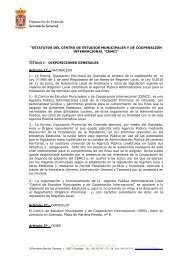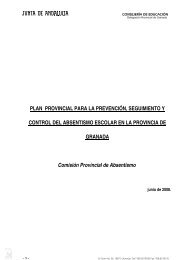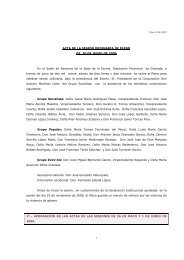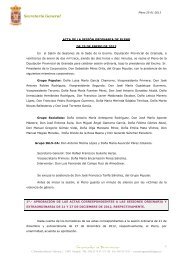manantiales granada_cero.qxp - Diputación de Granada
manantiales granada_cero.qxp - Diputación de Granada
manantiales granada_cero.qxp - Diputación de Granada
Create successful ePaper yourself
Turn your PDF publications into a flip-book with our unique Google optimized e-Paper software.
<strong>manantiales</strong> <strong>granada</strong>_uno.<strong>qxp</strong> 08/05/2006 21:10 PÆgina 62<br />
GUIA MANANTIALES GRANADA<br />
❖ CORTE HIDROGEOLÓGICO DE LOS BAÑOS DE ALHAMA<br />
ra - Las Guájaras y Vega <strong>de</strong> <strong>Granada</strong>), recientemente<br />
se asocian estos <strong>manantiales</strong> a los<br />
materiales carbonatados <strong>de</strong> las unida<strong>de</strong>s<br />
rondai<strong>de</strong>s o <strong>de</strong> dorsal que afloran, <strong>de</strong> manera<br />
muy reducida, junto al bor<strong>de</strong> meridional <strong>de</strong><br />
la Depresión <strong>de</strong> <strong>Granada</strong>, así como al sistema<br />
<strong>de</strong> fracturas profundas <strong>de</strong> dirección E - O<br />
y NE - SO, que dieron origen a la propia Depresión<br />
<strong>de</strong> <strong>Granada</strong> durante el Mioceno.<br />
El impermeable que sella el citado acuífero<br />
carbonatado está constituido por los materiales<br />
margosos y lutíticos <strong>de</strong>l Mioceno<br />
superior.<br />
Las fracturas profundas <strong>de</strong> dirección E - O<br />
y NE - SO a las que está ligado el manantial,<br />
favorecen el ascenso <strong>de</strong> las aguas confinadas<br />
en el acuífero carbonatado, cuya surgencia<br />
en superficie se produce con la suficiente<br />
rapi<strong>de</strong>z como para que se conserven,<br />
en gran medida, sus iniciales propieda<strong>de</strong>s<br />
mineralógicas y <strong>de</strong> temperatura.<br />
62<br />
❖ Los recursos hídricos sobrantes son drenados<br />
al cauce <strong>de</strong>l río Alhama, convirtiendose en un lugar<br />
<strong>de</strong> atracción para bañistas.<br />
Baños <strong>de</strong> Alhama<br />
100<br />
80<br />
60<br />
40<br />
Caudal (l/s) ❖ HIDROGRAMA (Baños Viejos)<br />
20<br />
14<br />
12<br />
10<br />
0<br />
8<br />
6<br />
4<br />
2<br />
0<br />
1983<br />
pH<br />
1987<br />
60<br />
50<br />
40<br />
30<br />
20<br />
10<br />
0<br />
Tª (ºC)<br />
1991<br />
Fecha (años)<br />
Un conjunto <strong>de</strong> fracturas<br />
favorecen el ascenso <strong>de</strong>l<br />
agua <strong>de</strong>s<strong>de</strong> las<br />
profundida<strong>de</strong>s, conservando<br />
sus iniciales propieda<strong>de</strong>s<br />
mineralógicas y su<br />
temperatura<br />
❖ CARACTERÍSTICAS FÍSICAS (Baños Viejos)<br />
900<br />
800<br />
700<br />
600<br />
500<br />
400<br />
300<br />
200<br />
100<br />
0<br />
1995<br />
Min (µS/cm)<br />
1999<br />
Baños <strong>de</strong> Alhama<br />
❖ CARACTERÍSTICAS QUÍMICAS (Baños Viejos)<br />
Mg<br />
(3,51)<br />
Cl<br />
(1,78)<br />
Los caudales aforados en el manantial<br />
durante el período 1982 -<br />
1990 han venido oscilando entre<br />
los 14 y 110 l/s si sumamos los<br />
Baños Viejos y los Nuevos.<br />
SO4<br />
(4,71)<br />
Ca<br />
(4,79)<br />
Unida<strong>de</strong>s en meq/l<br />
Na<br />
(1,65)<br />
HCO3<br />
(3,1)<br />
63
















